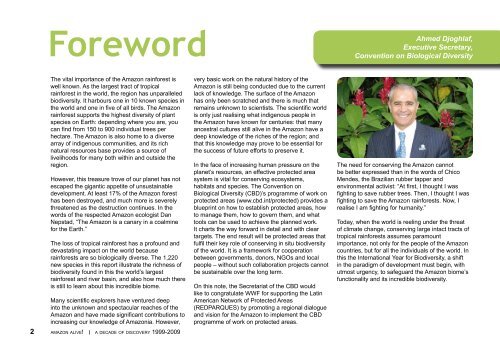Amazon Alive: A Decade of Discoveries 1999-2009 - WWF
Amazon Alive: A Decade of Discoveries 1999-2009 - WWF
Amazon Alive: A Decade of Discoveries 1999-2009 - WWF
You also want an ePaper? Increase the reach of your titles
YUMPU automatically turns print PDFs into web optimized ePapers that Google loves.
Foreword<br />
Ahmed Djoghlaf,<br />
Executive Secretary,<br />
Convention on Biological Diversity<br />
The vital importance <strong>of</strong> the <strong>Amazon</strong> rainforest is<br />
well known. As the largest tract <strong>of</strong> tropical<br />
rainforest in the world, the region has unparalleled<br />
biodiversity. It harbours one in 10 known species in<br />
the world and one in five <strong>of</strong> all birds. The <strong>Amazon</strong><br />
rainforest supports the highest diversity <strong>of</strong> plant<br />
species on Earth: depending where you are, you<br />
can find from 150 to 900 individual trees per<br />
hectare. The <strong>Amazon</strong> is also home to a diverse<br />
array <strong>of</strong> indigenous communities, and its rich<br />
natural resources base provides a source <strong>of</strong><br />
livelihoods for many both within and outside the<br />
region.<br />
However, this treasure trove <strong>of</strong> our planet has not<br />
escaped the gigantic appetite <strong>of</strong> unsustainable<br />
development. At least 17% <strong>of</strong> the <strong>Amazon</strong> forest<br />
has been destroyed, and much more is severely<br />
threatened as the destruction continues. In the<br />
words <strong>of</strong> the respected <strong>Amazon</strong> ecologist Dan<br />
Nepstad, “The <strong>Amazon</strong> is a canary in a coalmine<br />
for the Earth.”<br />
The loss <strong>of</strong> tropical rainforest has a pr<strong>of</strong>ound and<br />
devastating impact on the world because<br />
rainforests are so biologically diverse. The 1,220<br />
new species in this report illustrate the richness <strong>of</strong><br />
biodiversity found in this the world’s largest<br />
rainforest and river basin, and also how much there<br />
is still to learn about this incredible biome.<br />
Many scientific explorers have ventured deep<br />
into the unknown and spectacular reaches <strong>of</strong> the<br />
<strong>Amazon</strong> and have made significant contributions to<br />
increasing our knowledge <strong>of</strong> <strong>Amazon</strong>ia. However,<br />
2 amazon alive! I a decade <strong>of</strong> discovery <strong>1999</strong>-<strong>2009</strong><br />
very basic work on the natural history <strong>of</strong> the<br />
<strong>Amazon</strong> is still being conducted due to the current<br />
lack <strong>of</strong> knowledge. The surface <strong>of</strong> the <strong>Amazon</strong><br />
has only been scratched and there is much that<br />
remains unknown to scientists. The scientific world<br />
is only just realising what indigenous people in<br />
the <strong>Amazon</strong> have known for centuries: that many<br />
ancestral cultures still alive in the <strong>Amazon</strong> have a<br />
deep knowledge <strong>of</strong> the riches <strong>of</strong> the region; and<br />
that this knowledge may prove to be essential for<br />
the success <strong>of</strong> future efforts to preserve it.<br />
In the face <strong>of</strong> increasing human pressure on the<br />
planet’s resources, an effective protected area<br />
system is vital for conserving ecosystems,<br />
habitats and species. The Convention on<br />
Biological Diversity (CBD)’s programme <strong>of</strong> work on<br />
protected areas (www.cbd.int/protected) provides a<br />
blueprint on how to establish protected areas, how<br />
to manage them, how to govern them, and what<br />
tools can be used to achieve the planned work.<br />
It charts the way forward in detail and with clear<br />
targets. The end result will be protected areas that<br />
fulfil their key role <strong>of</strong> conserving in situ biodiversity<br />
<strong>of</strong> the world. It is a framework for cooperation<br />
between governments, donors, NGOs and local<br />
people – without such collaboration projects cannot<br />
be sustainable over the long term.<br />
On this note, the Secretariat <strong>of</strong> the CBD would<br />
like to congratulate <strong>WWF</strong> for supporting the Latin<br />
American Network <strong>of</strong> Protected Areas<br />
(REDPARQUES) by promoting a regional dialogue<br />
and vision for the <strong>Amazon</strong> to implement the CBD<br />
programme <strong>of</strong> work on protected areas.<br />
The need for conserving the <strong>Amazon</strong> cannot<br />
be better expressed than in the words <strong>of</strong> Chico<br />
Mendes, the Brazilian rubber tapper and<br />
environmental activist: “At first, I thought I was<br />
fighting to save rubber trees. Then, I thought I was<br />
fighting to save the <strong>Amazon</strong> rainforests. Now, I<br />
realise I am fighting for humanity.”<br />
Today, when the world is reeling under the threat<br />
<strong>of</strong> climate change, conserving large intact tracts <strong>of</strong><br />
tropical rainforests assumes paramount<br />
importance, not only for the people <strong>of</strong> the <strong>Amazon</strong><br />
countries, but for all the individuals <strong>of</strong> the world. In<br />
this the International Year for Biodiversity, a shift<br />
in the paradigm <strong>of</strong> development must begin, with<br />
utmost urgency, to safeguard the <strong>Amazon</strong> biome’s<br />
functionality and its incredible biodiversity.

















